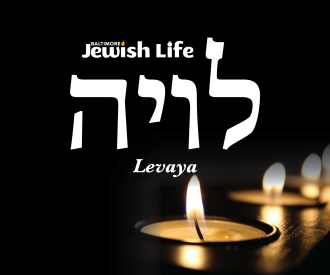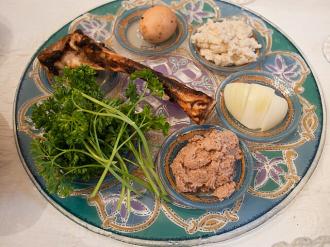1) Tzaraas: A Spiritual Malady
Ramban’s famous opinion, which is agreed upon by the Rambam and the Kuzari, is that tzaraas is not a physical malady. Tzaraas is a spiritual malady with a physical manifestation, but it is not contagious.
Garment Tzaraas
“V’habeged ki yihiyeh bo negah tzaraas” (13:57). If one has a garment that has tzaraas. Ramban says this is not a natural malady at all. It wasn’t something that was around in the world. Nigei batim, clothing and on human beings was only something that when the Jews were shelamim with Hashem, when the Jews were in a place of working on their spiritual greatness, and the ruach Hashem was upon them at all times, if they did certain aveiros, and the gemara in Eirichin and multiple other places tells us that it wasn’t just lashon hara that brought tzaras.
When there is fighting among people and saying negative things about others, then their bodies and their clothing and their houses would be inflicted with tzaraas as a way to remind them of their spiritual deficits. One of the purposes of going to the cohen and not to the doctor was because the cohen would tell you the spiritual malady that you had that was causing the tzaraas, so that you could work on yourself.
Rambam in the end of Hilchos Tumas Tzaraas basically says this, and the the Kuzari, chelek beis (61a) says this as well. Tzaraas was a spiritual reminder.
Three Proofs
Rav Shimon Schwab quotes Rav Shamshon Rephael Hirsch who brings down three significant proofs that tzaraas is not what we call leprosy, as many of the older translations tried to give it that meaning, but rather it is a spiritual malady.
Proof #1: Olei Regel
There is a halacha that during the time of oleh regel a cohen does not check someone to declare him tamei with tzaraas. So, if you think about it if it’s this contagious malady, then why would you not check him out then?! He’s going to be around people; there’s going to be thousands, maybe even millions of Jews, whom he can infect! Obviously it’s not a contagious malady.
Proof #2: Chosson and Kallah
A chosson and kallah are not checked for tzaraas (Mishna Negaim). So, once again there are two people that are getting married and they’re going to be exposed to each other, if it’s a dangerous malady, then we should not expose them to each other.
Proof #3: “Kulo Hafach Lavan Tahor”
The most compelling proof is that if kulo hafach lavan, if you’re entire body is covered from head to toe with tzaraas, you’re tahor. Thus, it cannot be a physical malady, because this man would be the ultimate contagious person! The mefarshim and the baalei mussar explain that he is considered tahor because he’s hopelessly not taking care of his spiritual malady, so the Torah says: All right, forget it, you are beyond repair. This will hopefully get his attention and bring him to repent.
Rav Schwab ends with one interesting thought about the haftorah for parshas Metzorah which is the story about Geichazi and his sons who all got Naaman’s tzaraas. He brings proofs that perhaps in this case it was actually a physical leprosy and it was not just a spiritual leprosy, and that there is such a concept of physical leprosy that people do get. But, the tzarass in the Torah is not a contagious biological malady.
2) Humoristic Medical Terminology
My second thought is to share with you what I believe is a fundamental introduction to the field of medicine. We know that the Ramban and the Rambam were doctors. The Ramban was probably an OB, and he dealt with delivering babies that we know from a number of letters from his cousin, Rabbeinu Yonah who actually chastises him for birthing non-Jewish babies, and the Ramban, of course, argues with him and says that’s it’s perfectly permitted, m’pnei darchei shalom, and the minhag is and it still is that, of course, we take care of anyone in need as a doctor, and they will take care of us when we come to them in need as well, and that’s the halacha. Rav Moshe Feinstein has a famous teshuva about this as well about hatzalah responding on Shabbos to a non-Jew, etc.
Four Humors
I wanted to talk about what is considered one of the most ancient aspects of medicine. They were very holistic back then, and they believed in the four humors. It’s called humourism, or some people will call it humoralism. It was a system of medicine that broke up the human body into four humors or bodily fluids and it came from the ancient Greeks and the Roman physicians and philosophers (the two were related. Philosophers studied science and became experts in the human body), just like the Rambam himself was a great doctor and philosopher.
Basically, the theory posits that an excess or deficiency of any of the four humors directly influenced your temperament and your health. And, there’s just some fascinating things.
So, first we’ll explain this, and then we’ll come back to the Ramban, who, basically gives a medical description of tzaraas, which I find very fascinating. So, first let’s talk about it.
Division of Four
The four humors of Hippocratic medicine are black bile, which is known as mara shechora, which basically translates as depression. Bile is a chemical in the gallbladder, and in Greek it’s actually called melancholy. So, that’s where the word ‘melancholy’ which means sadness and depressed state comes from. The next one is yellow bile, which we’ll talk a little more about what that is, and that’s contrenicholy. Then there’s phlegm, which in Greek is phlemda. Then there’s blood which is hima in Greek, which might come from the word chaim, life. I don’t know.
Each one corresponds to four temperaments. The humourous system of medicine was something that was very individualistic because every every patient that was seen had their own unique humoural composition, and therefore, the doctor had to assess what was going wrong. Where you had excess, where you had too much. The rishonim talk about this as well.
Foods Impact the Humors
We talked last week about certain fish and what they do to a person. That, perhaps, eating fish is damaging to certain people, or eating fish and meat together might impact the humors and that’s why it was something that might have been considered dangerous, or, perhaps, eating fish with cheese, which there’s a whole machlokes if it’s an issur or not. Whether it’s a printing mistake in the Shulchan Aruch or not. But, either way, we’re not going to go into the halachic part, but there’s some fascinating things.
Greek, Roman, Islamic and European Physicians Until Modern Medicine
From the time that Hippocratic Medicine became famous, the humoral theory was basically adopted by Greek, Roman and Islamic physicians, and became the most commonly known view until even reaching down to the European physicians, until the modern medical research in the nineteenth century changed that. So, until the late eighteen hundreds this was the number one system. It was very holistic.
Imbalance or Corruption of the Humors
Basically the theory says that there’s four basic substances in the body, and their in balance when a person is healthy, but diseases and problems come from a result of excess or a deficit in one of the four humors or more, or a corruption in one of those. This is because of things that you inhaled or absorbed in your body, and like I said it’s black bile, yellow bile, phlegm and blood. So, let’s explain a little bit more.
Four Elements, Seasons and Organs
The theory was developed, very much so, over hundreds of years to even include this concept that it even represents the four elements of: earth, fire, water and air. Earth is the black bile, so it’s the lowliness and depression, fire is a yellow bile, so there’s vitality and perhaps anger there. Water is phlegm, and all the four elements are present in the blood itself. That is one concept. There are many other theories as well. They correspond to spring, summer, autumn and winter. And different organs. The blood corresponds to the liver. And, yellow bile corresponds to the spleen, and black bile is the gallbladder, and phlegm and water refers to the brain. There’s many, many qualities about what’s moist and what’’s warm and what’s dry and cold, and what the temperaments are.
Temperamental Effect
So, let’s go through this basically. If you have too much yellow bile, then you were said to have been aggressive and very angry. If you have too much black bile you were said to be depressed. If you had too much phlegm, you were phlegmatic, then you were apathetic. And, again, there’s even research papers written in the early nineteen hundreds that discuss these ideas. Apparently, even today, in some medical schools it’s still taught. So, these are some very, very fascinating things.
Robin Farrus: Blood Clotting
Dr. Robin Farrus, a Swedish physician, in 1921 suggested that the four humors were made up, based on the fact that they observed blood clotting in a transparent container. Basically, what happens is when you take blood, and you draw it in a glass container, and it’s left untouched for about an hour you get hour different layers of color. So, there’s a dark clot that forms at the bottom. It’s called black bile. That would have been called, perhaps, black bile. And, then above the clot is a layer of red blood, which is the blood itself, and above that is a whitish layer which might have been the phlegm. And, the top layer is a clear yellow, which might have been the yellow bile.
Health
Hippocratic medicine taught these ideas. Health is primarily a state in which these constituit substances are in their correct proposition to each other. Both in strength and quantity as well, as well as being well mixed. Pain occurs when one of the substances presents either a deficiency or an excess or a separation in the body and not mixed with the others. And, this is what we have really, really fascinating idea about temperaments and what fever is and how these things work and how people were cured, so to speak, and again there’s hot, dry, wet and cold which we’ll talk about a little bit when we look at this Ramban.
Tzaraas and the Humors
Ramban was aware of this and thus explains what tzarass was. He’s trying to give us a medical understanding of how the Torah and medicine overlap.
S’eis, Sapachas and Baheres
“S’eis oh sapachas oh baheres (13:2).” If you have on your skin a s’eis, sapachas or baheres. Ramban quotes Rashi. “Shemos negaim.” They’re just the names of tzaraas and one is whiter than the next. That’s what Rashi says. Ramban quotes the Ibn Ezra about the etymology of these things. He says that Rav Avraham Ibn ezra says that s’eis is a term that means burning. Like we find in the pasuk the blaze, maseis, has began and Dovid “vayisaeim.” Dovid burnt them. It could be that this is called that because the fire is called mas’eis because it means to go upward. Naso is to lift up because that is the nature of fire. To rise upward. That’s a burning, rising sensation. Sapachas is “safachti na”. It means to attach me. That’s what sapachas means. It’s a form of attachment. So, it’s a sickness that coalesses in one particular area. Baheres comes from the word “bahir hu basichakim”. So, it means that it’s bright in the sky. So, it makes a mark and a sign on me.
Therefore, says the Ramban, he says: I suggest that s’eis is a nega that would correspond to burning yellow bile. S’eis would be from mara yeroka hanesrefes. Baheres would come from leicha levanah which would come from white humor. So, that’s what baheres would mean. Sapachas would be something that comes from both. Compounded from both these two things. He concludes: Our rabbis said otherwise. They said that s’eis is lashon gavoha. They had different translations, but the two might be able to be reconciled.
Torah is timeless
These are just different ideas when we learn through Chumash everything is here. This is a medical history of the world, of how things looked back them in the medical field in the late eleven hundreds. And, what we see is that the Torah is timeless. The Torah corresponds to medical terms and the Torah understands medicine. The Torah is the source of all chochmah. Everything comes from there. And, when we think about this it’s just an amazing thing to just go through the parshious of tzaraas, and to understand that, first of all, it’s a message that Hashem is trying to give us, but more than that, as well, that one of the lessons behind it is that Hashem is watching everything that happens and keeping track of us, and it’s just so fascinating to see how the Ramban’s medical knowledge enhanced his Torah knowledge as well.
We should be zocheh to connect with the Torah and the lessons the Torah has explicit lessons as well to teach us about the laws. How to serve Hashem and about how to have good middos, and then more esoteric and hidden part that we could study and then appreciate is, of course, the parts that teach us about the beauty and the greatness of Torah and how much Torah dictates the world and the entire existence. Bereishis – “bishveal reishis.” That’s the entire purpose of the the world.
---
Rabbi Yosef Tropper is a rav and psychotherapist. Learn more and subscribe at ParshaThemes.com
















